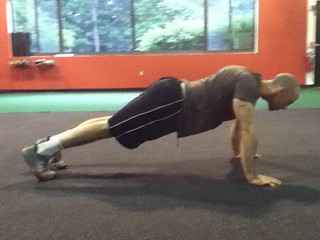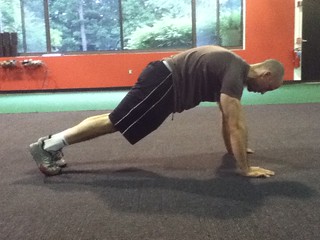Q: My fellow lifter in Germany has long maintained that the things that happen to me under the bar are just plain weird. As it happens, I’ve not yet seen anyone write on this (if you did and I missed it, just point me there!); I hope you’ll be able to help me figure out what on earth is going on.
I love deadlifts, but it seems they absolutely hate my right forearm. At all of 95lbs, double overhand, I start feeling a mildly painful strain at the elbow when I close my hand. As the weight goes up, the pain gets worse.
Last year, I ignored the pain thinking it was something that would get better with time. Instead, by the time I got to 190lbs, the pain was so hideous that I couldn’t even open the refrigerator door without wanting to cry. It took five months of strict rest for it to heal.
I definitely don’t want to go through that again! What annoys me even more is that 190 is well short of what I could break from the floor if whatever-this-is wasn’t doing what it’s doing (left arm has no issues at all). What on earth is going on here, and how do I make it stop???
A: Hi Jackie, thanks for writing and sorry to hear about your grip issues. I know how frustrating it can be to be hurt and unable to train like you’d like, so hopefully I can offer some insight.
But first, given you’re writing to me all the way over from Germany, can you answer me just one minor question?
What is up with the obsession German’s have with David Hasslehoff??????
I’m not going to sit here and pretend that I didn’t idolize the guy back in his Knight Rider days, and I certainly have to give my man kudos for rocking the 80’s mullet and chest hair like a boss…….
But German’s take things to a whole different level and go bat-shit crazy for the guy.
What gives?
Please, tell me, it’s killing me.
Okay – with that out of the way, lets state the obvious: while it’s pretty much impossible for me to make any definitive assertions over the internet without being able to observe you in person, I have a few comments/insights.
1. It sounds like you need to get some aggressive soft tissue work done. Honestly this is the best piece of advice I can give you and takes precedence over everything else.
The forearms and by extension – the elbow – is a very “claustrophobic ” area where a lot of “stuff” converges in a small area resulting in a lot of friction that takes place amongst muscle, ligaments, facia, and other soft tissue.
On the medial side you have all the muscles in the forearm that flex the wrist (I could list them all here, but it’s early and I don’t feel like it. But trust me: they’re there) which connect to the medial epicondyle via the common flexor tendon, with the pronator teres (which I suspect is going to be a HUGE player for you) attaching nearby.
The same can be said on the lateral side: you have all the muscles in the forearm that extend the wrist which connect to the lateral epicondyle via the common extensor tendon.
Posteriorly you have all three heads of the trciep attaching to the olecranon via another common tendon.
And lastly, anteriorly, you have the attachment points of the bicep brachii, brachioradialis, and brachialis on the elbow.
See what I mean? There’s a lot going down in one teeny tiny area.
We call it a Zone of Convergence, and it stands to reason that if your forearm is that painful whenever you grab a pencil, let a lone a barbell, you have poor tissue quality in that area.
Just resting – while it may alleviate the symptoms temporarily – won’t get at the root of the problem. To that end, I can’t stress enough how crucial it will be to seek out a reputable manual therapist – someone who can perform Graston or Active Release Therapy – to treat that area.
As I noted above I have my suspicions that the pronator teres (which, as the name suggests, pronates the forearm) is on fire and that you need to take a bit of a grenade approach in terms of addressing the entire spectrum.
While manual therapy takes priority, you can take the self myofascial release route and use something like The Stick on the forearms, biceps, and triceps.
2. Another less obvious – albeit equally as important – thing to consider is something that many people overlook. While soft tissue restrictions in the forearm and elbow area make a lot of sense and is a great place to start, it’s not uncommon for everything to manifest itself higher up the kinetic chain into the brachial plexus area – upper traps, neck, etc.
The brachial plexus is basically an area where a network of nerves start at the spine, run through the neck, and all the way down to the elbows, forearms, and to each finger
If you’re someone who spends a fair amount of time in an office staring at your computer, that area is notorious for getting gunked up (<— how’s that for a technical term?) and it may bode in your favor to have a manual therapist perform some work there as well.
Moreover, this is also an opportune time to run an audit on your breathing patterns. If you’re someone who’s a “chest breather,” meaning whenever you take a breath you tend to rely on your accessory breathing muscles like the upper traps, levator, scalenes, etc, it’s no wonder you’re jacked up!
Think about it: you take upwards of 20,000 breaths everyday. Not that every breath is going to be “optimal,” but it stands to reason that if you’re a dysfunctional breather bad things may happen.
Taking the time to address something as simple as how you breath, becoming more of a “belly breather,” and learning to use your diaphragm more efficiently, can go a long ways. More than you think.
Check out THIS post I wrote last year on the topic.
3. As a corollary to the above, it’s also important to run a check on your technique on stuff like push-ups, rows, and chin-ups. If you’re someone who has a tendency of shrugging everything – and relying too heavily on the upper traps to do everything – that’s just going to feed into the issue(s) at hand.
While addressing soft tissue quality and breathing patterns are high on the “to do” list, it’s going to be a waste of time if all you’re doing is heading back to the gym and shrugging everything.
So, you might as well give yourself an audit on those things too. Just something to consider. I know everyone thinks their technique is spot on, but I can assure you that everyone needs a little tweaking.
I realize it wan’t the sexiest answer in the world, but hopefully it helps a few people out there.
But seriously, Hasslehoff……what’s the deal?




